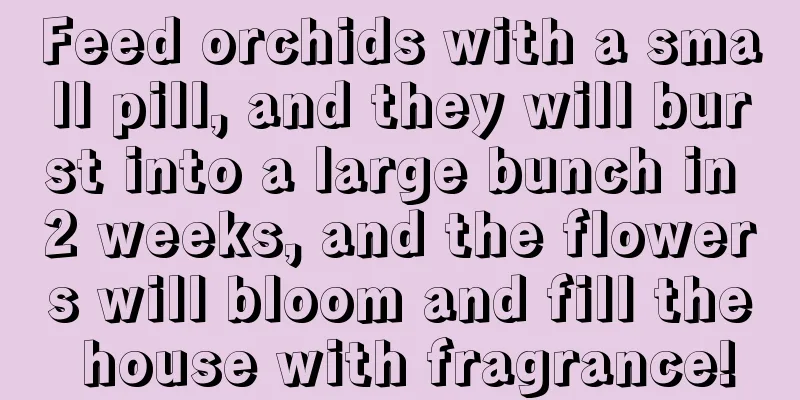If a flower's roots rot, it will die. Throw some of this into the pot and it will come back to life immediately!

Why do flowers rot?It is so common for flowers and plants to have yellow leaves, fall leaves, flowers, and wilt that many flower lovers can't believe it. This is a sign of root rot. The reasons for root rot are also very clear. Let's see if you have been affected: 1. Overwatering Overwatering is the most direct reason. Some flower lovers are too diligent. They water today and tomorrow. The flowers are obviously full of water, but the remaining water soaks the roots in the flowerpot. It would be strange if they don't rot. 2. The soil in the pot is not loose The soil is too compact and too tight, so the roots can’t breathe. They are already suffocating, and adding water will only add fuel to the fire. 3. The roots are damaged Many newly bought flowers are prone to root rot. In fact, the roots are already damaged. New potted plants are usually divided in the nursery. If the division is damaged, the flowers will be scarred when they are bought back. 4. The location is not ventilated A ventilated environment is conducive to the evaporation of water, so you don't have to worry about the flowers absorbing the remaining water. Some flower lovers put them in a corner, which is really "putting them to death". What to do after root rotThe manifestations and treatment methods of root rot of camellia, jasmine, osmanthus, woody roses, money trees, gardenias, etc. are roughly the same. Huahua will take camellia as an example here. 1. Symptoms of root rot The roots, flowers and leaves are all one. When the leaves droop and wilt, the flowers fall off for no reason, and the leaves also fall off, these are all problems with the roots. 2. Dig out, check and clean up rotten roots If you suspect the roots are rotten, dig them out and take a look. Be careful to clean off the excess soil around the roots (you can rinse them off with water). White roots are generally healthy, while black, soft and rotten ones are bad. Remove the rotten roots, regardless of the size of the root system, and cut until the fresh roots are reached. After cleaning, soak them in carbendazim solution for 20 minutes to sterilize. If more than 90% of the roots are rotten, just chop off the roots and leave only the wooden flower stems. Soak them in rooting water and let them take root. Depending on the type of flower, it will take about 20-30 days for the roots to take root. 3. Change the soil and plant again You need to use loose soil for replanting. Ordinary garden soil mixed with sand is very good. In order to sterilize, you can first pour boiling water on it and let it air dry before using it. 4. Subsequent watering and lighting After repotting, water thoroughly and place in a cool and ventilated place, avoid direct sunlight. After about 5-8 days, move to the balcony for slow sun exposure. How to avoid root rot1. The potting soil should be loose and breathable In order to make the flower soil more breathable, you can mix some particles: vermiculite, volcanic stone, perlite, medical stone, pumice, etc. Ordinary gravel is also fine, but it must be soaked in carbendazim solution for sterilization. 2. Use flower pots as pads Put some bricks or nut shells (don't use salty ones) at the bottom of the flowerpot to help water seep in and prevent the soil from becoming hardened. 3. Reasonable watering There are many kinds of flowers, and everyone must be worried about watering them. In fact, just remember one sentence: water only when the soil is dry. So how do you judge whether the soil is dry or not? A small bamboo stick can do it. Stick a bamboo stick (toothpick is also OK) into the soil, pull it out after a while. If the bamboo stick is relatively moist, you don’t need to water it. If the bamboo stick is dry, water it quickly. 4. Place it in a ventilated place Plants that are not resistant to sunlight, such as green radish, Clivia, and Chlorophytum, can be placed on the north balcony. Camellia, jasmine, gardenia, and money tree can be placed in the living room near the balcony, which is both ventilated and convenient for appreciation. Root rot is not a big problem Just pay a little attention during the raising process It can be avoided completely |
<<: How to deal with calla lily root rot
>>: How to switch from soil-grown Clivia to hydroponics
Recommend
How to care for newly bought succulents
1. Check and prune the roots Be sure to check the...
How to grow the bird's nest faster
1. Soil selection When choosing what kind of soil...
What should you pay attention to when raising orchids every month?
What should I pay attention to when growing orchi...
Top 10 formaldehyde removal plants: the best green potted plants for absorbing formaldehyde and purifying the air
We actually spend most of our time indoors, so th...
How much does a peace tree cost?
1. Price The price of the peace tree varies depen...
Which season is better for planting succulents?
Nowadays, many people grow several pots of succul...
How to grow Teyulian in autumn
1. Proper watering Autumn is its growing season. ...
Hydrangea's growing environment and growing conditions
Hydrangea Growth Environment and Conditions Hydra...
Cultivation methods and precautions of large-leafed evergreen
Cultivation method of large-leafed Dieffenbachia ...
What to do if the leaves of Strelitzia turn yellow and crack
what to do If the leaves of Strelitzia reginae cr...
How many years does it take for yellow wood fragrance to bloom? Does yellow wood fragrance have fragrance?
1. How many years can it bloom? As a rose variety...
What are the varieties of precious flowers?
1. Orchid Orchid is a relatively precious flower,...
How to pollinate yew
1. Male pollen collection When the male flower bu...
Sheep farming techniques and methods
Sheep have become one of our main livestock for p...
What are the characteristics of creeper? Complete picture of creeper
1. Characteristics of creeper Strong climbing abi...









